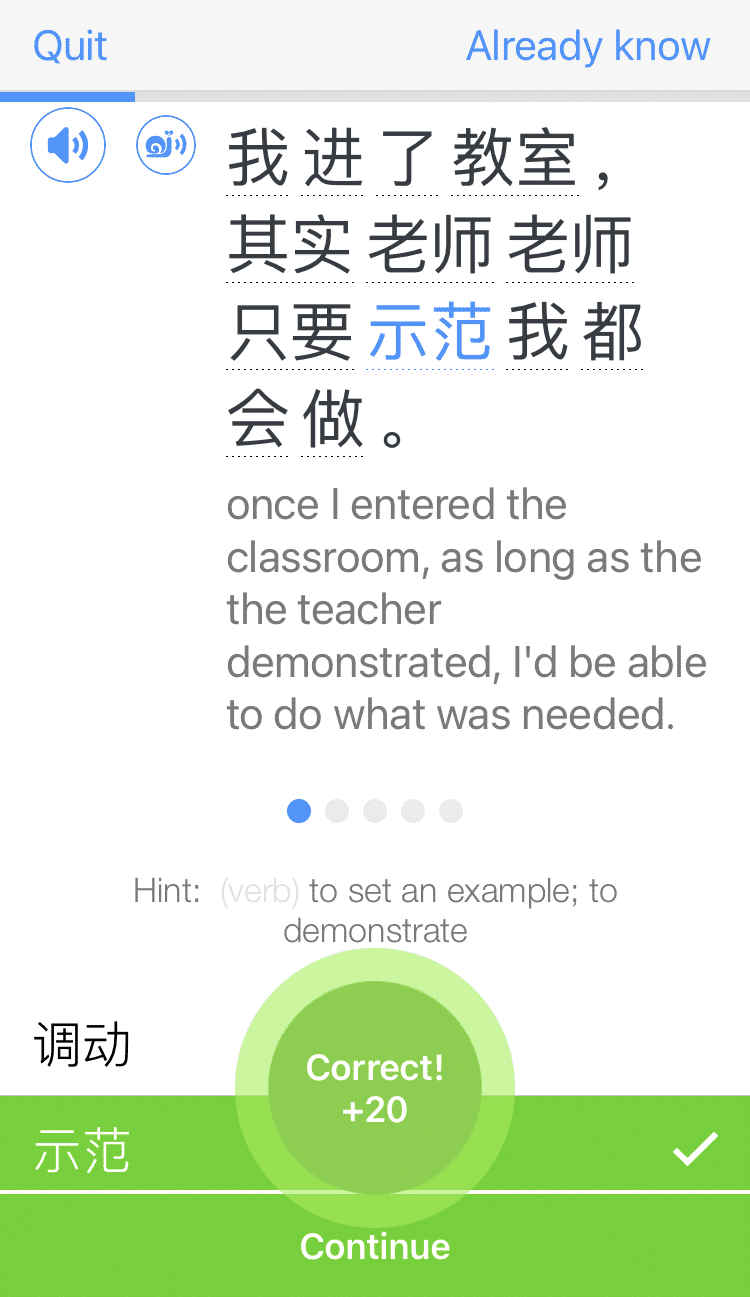
How to Learn Chinese in 3 Months: 9 Must-use Strategies to Get Fluent Fast
With the right study techniques and attitude, you can make massive progress in Chinese in three months.
And if having a Mandarin conversation is your primary goal, you can do so even if you’re starting from zero.
So in this post, we’ll go over a step-by-step plan you can use to learn Chinese in three months.
Contents
- 1. Memorize Chinese Characters in Chunks
- 2. Practice Reading Tactically
- 3. Work with a Tutor to Supercharge Speaking and Pronunciation Skills
- 4. Practice Writing in Longhand
- 5. Use Chinese Radio Shows and Podcast Episodes to Your Advantage
- 6. Watch TV Shows and Movies in Chinese
- 7. Socialize in Chinese for One Hour per Week
- 8. Use Social Media in Chinese
- 9. Read Passively in Chinese Once at the Intermediate Level
- How to Get the Most Out of Your 3 Months to Learn Chinese
- And One More Thing...
Download: This blog post is available as a convenient and portable PDF that you can take anywhere. Click here to get a copy. (Download)
1. Memorize Chinese Characters in Chunks
Learning characters is essential to Chinese fluency. But most learners would agree it’s not the easiest part of learning the language.
Here’s a strategy for learning as many characters as possible in three months.
Start out by learning the 214 Kangxi radicals.
These are the building blocks of Chinese characters. It’s not like learning the alphabet, but it’s as close as you’ll get in Chinese. Mastering these 214 radicals will make learning Chinese characters faster for you in the long run.
While you’re working on learning the radicals, start tackling the 1,000 most common Chinese characters.
According to research, knowing the top 1,000 most common characters would allow you to understand about 90% of the Chinese language.
And if you learn 11 characters per day, you’ll be able to get through the 1,000 most common characters in about three months.
Combining this with learning the 214 Kangxi radicals will make learning the characters much easier and more likely to stick.
There are a number of tools you can use to help learn characters.
For learning to both read and write them, I think Skritter is the best. Some other options include Zizzle, Memrise and Anki.
2. Practice Reading Tactically
If you’re going to boost your reading skills in three months, you probably won’t want to dive into any old book written in Mandarin Chinese.
Instead, start with graded readers.
These are books designed for a Chinese learner audience. So the vocabulary and complexity are written to cater to different learning levels.
If you’re studying intensively throughout your three months, see if you can increase the difficulty of your graded readers every week or every two weeks.
Some resources for graded readers include Mandarin Companion, ChineseReadingPractice and The Chairman’s Bao.
After you’ve spent some time with graded readers, start reading a book you’re already familiar with that has been translated into Chinese.
This will help you pick up new vocabulary and get exposed to written Chinese without worrying about getting lost in the plot.
I like to recommend the “Harry Potter” series because it’s written for children and young adults, so the language isn’t too complex, and you’re probably already familiar with it.
3. Work with a Tutor to Supercharge Speaking and Pronunciation Skills
The fastest way to improve your pronunciation and speaking abilities is to hire a private tutor.
That’s because tutors can provide expert personalized attention. They’ll hear the errors you don’t know you’re making and will coach you to better pronunciation.
It’s a much quicker and more precise way to improve your speech than trying to imitate Chinese audio content or even being part of a class with several other students.
You can hire a tutor via Skype or an in-person tutor. I personally think in-person tutors are slightly better.
It’s easier for a tutor who’s sitting at the table with you to give you pointers about where to place your tongue when you make a particular sound, and there are no issues with poor audio quality. In-person tutors are usually much more expensive, though.
An easy platform for finding Chinese tutors online or in your area is Wyzant. You can quickly search for many qualified tutors and narrow down by filtering based on their rates, qualifications, distance from you and more.
The site italki is another good option if you’re interested in one-on-one lessons online.
Use your time with the tutor to drill your pronunciation and work on both spontaneous and practiced speaking.
Ideally, your tutor is a trained language teacher who understands foreigners’ difficulties with Chinese phonetics and tones.
4. Practice Writing in Longhand
Part of your learning plan involves writing in Chinese. Longhand.
Yes, you’ll probably spend most of your life in Chinese tapping out text messages on your iPhone.
But writing by hand is key to building a strong foundation in the language and solidifying your grasp on characters.
It’s also an excellent way to practice grammar.
Proper grammar (or lack thereof) is most obvious in the written form, so writing in longhand will help reveal weaknesses or holes in your understanding of how to form sentences in Chinese.
Of course, you won’t always be able to spot those weaknesses or holes yourself, so make sure you get your writing corrected.
The best way to do this is to dedicate the last 10 minutes of your tutoring session to reviewing your written work.
5. Use Chinese Radio Shows and Podcast Episodes to Your Advantage
Chinese audio materials—like radio shows and podcasts—are goldmines for learning Mandarin.
The most popular way to use them as resources is to listen to them passively.
This means you’re listening to a podcast while doing other tasks, such as commuting to work, washing the dishes, making dinner or taking a shower.
This type of passive listening is excellent for immersing yourself in Chinese, getting used to the sounds and learning to pick up words without having to focus really hard.
Plus, it’s a way to squeeze in some Chinese practice even when you don’t have much energy.
But you can also use Chinese audio resources actively. Here are some ways you can extract meaningful lessons from them:
- Do listening comprehension drills. Here’s one of my favorite drills to improve my listening skills. Choose a song or podcast episode with available lyrics or a transcript. Line by line, write down on paper what you hear in Chinese. After working through a predetermined section (i.e., verse of a song, one minute of an episode, etc.), stop and check the lyrics or transcript to see how much you got right.
- Listen while reading a transcript. Try to choose a podcast or radio show with available transcripts so you can read along while listening. This will train your ears and help your brain associate words with the right sounds.
- Shadow the audio. Shadowing is an excellent speaking and listening exercise that involves listening to an audio and then repeating after the native speaker immediately after you hear them. It’s tough at first, but you’ll get used to it (and it’s totally worth it)!
- Identify new words and structures in the transcripts. Read over your transcript again and highlight new words, phrases and grammar structures you’re unfamiliar with. Then, turn them into flashcards and study them like you would any other new vocabulary.
You can search for Chinese language podcasts on the iTunes store or check out our favorite Chinese podcasts here.
6. Watch TV Shows and Movies in Chinese
You can apply the above active study tips when watching Chinese movies and shows, or you can watch them passively like you watch content in English.
The point is to turn your daily English activities into Chinese activities—including what you watch.
It’s also essential that you choose the right Chinese content.
Don’t go for movies or shows that are too much above your head—I’m talking crime, thrillers, mysteries, science documentaries, etc.
But you also don’t want to get bored and need something to keep bringing you back. So choose something you’d actually want to watch if it were in English.
To find Chinese movies and shows, you can use CCTV or Youku. This will give you the Chinese perspective on some issues—though it’s also worth noting that some radio and TV options are state-owned, and therefore the information may be skewed.
You can also check these posts for a comprehensive list of Chinese movies and TV shows:
7. Socialize in Chinese for One Hour per Week
If you live in China, this isn’t hard. If you don’t live in China, seek out places and events frequented by Chinese speakers.
You can usually find Chinese language groups on Meetup.com. There are often Chinese language events in major cities at the public library.
If you have no luck there, you can also socialize in Chinese online. You can make Chinese-speaking friends from anywhere in the world thanks to language exchange apps like HelloTalk and Tandem. (You can read our in-depth HelloTalk review here).
The premium versions of these apps let you filter for language partners in your area.
But even if you aren’t interested in a local partner (or there aren’t many options), you can connect with native speakers in China through the apps’ built-in text messaging, audio call and video call features.
Try to have at least one hour of conversations—either in person, over call or on video call—in Chinese each week.
Once you’re comfortable, you can add to that number.
8. Use Social Media in Chinese
Outside of language exchange apps, try to connect with native speakers on social media platforms.
This way, you’ll have more real-life experiences rather than those on an app specifically designed with language learners in mind.
You can follow famous Chinese influencers, find trending Chinese hashtags to explore new content and creators, change the language of your app settings to Mandarin and more.
There are also plenty of Chinese Twitter feeds, or you can join Weibo—basically China’s version of Facebook.
9. Read Passively in Chinese Once at the Intermediate Level
We talked about active reading, but once you reach an intermediate level, you can start passively reading books in Chinese.
This means reading without studying the content intensely (such as looking up every unknown word). But rather, you read for enjoyment and similarly to how you read in your native language.
To start, choose something that isn’t going to be a huge stretch to understand.
That way you’re motivated to come back and keep reading.
If you find that you can’t understand 70-80% of the content, choose something less advanced.
How to Get the Most Out of Your 3 Months to Learn Chinese
- Devote as much time as you can to studying Chinese. Spend as much time as you can on Chinese and as little time as possible using any other language. If possible, schedule your three-month study plan for a summer vacation from school, a sabbatical or any other time when you’re free from your regular obligations in your native language. But ultimately, the key to making progress is to devote the maximum amount of time to Chinese given your circumstances.
- Get as close to total immersion as possible. There are ways to mimic immersion at home, even if you can’t travel to a Chinese-speaking country. For example, you can use a program like FluentU which uses video clips from authentic Chinese media to teach you the language as it’s actually spoken by native speakers.
- Use active and passive learning to maximize your progress and avoid burnout. You’ll need to spend time speaking, writing and studying characters. These activities are essential for learning, but they’re also exhausting. Rather than studying nonstop for three months, you’ll need to relax with a movie every now and then. You can use any of the passive study techniques we’ve discussed today.
- Stack activities to make the most of your time. You’ll want to be exposing yourself to Chinese all the time, including when you’re eating breakfast, washing dishes and taking a shower. For example, you could listen to a podcast as you eat breakfast and prepare for the morning. And you can read for 10 minutes before bed at night.
Even if you’re not expected to give a speech in Chinese before the seasons change, an intensive three-month study period is an amazing way to improve your Chinese skills.
And as you see rapid improvement, your motivation will also increase.
We can’t maintain daily intensive study sessions forever, but most people find that three months is the perfect duration.
So no matter where you are now, see how much Chinese you can learn in the next three months!
Download: This blog post is available as a convenient and portable PDF that you can take anywhere. Click here to get a copy. (Download)
And One More Thing...
If you want to continue learning Chinese with interactive and authentic Chinese content, then you'll love FluentU.
FluentU naturally eases you into learning Chinese language. Native Chinese content comes within reach, and you'll learn Chinese as it's spoken in real life.
FluentU has a wide range of contemporary videos—like dramas, TV shows, commercials and music videos.
FluentU brings these native Chinese videos within reach via interactive captions. You can tap on any word to instantly look it up. All words have carefully written definitions and examples that will help you understand how a word is used. Tap to add words you'd like to review to a vocab list.
FluentU's Learn Mode turns every video into a language learning lesson. You can always swipe left or right to see more examples for the word you're learning.
The best part is that FluentU always keeps track of your vocabulary. It customizes quizzes to focus on areas that need attention and reminds you when it’s time to review what you’ve learned. You have a 100% personalized experience.
Start using the FluentU website on your computer or tablet or, better yet, download the FluentU app from the iTunes or Google Play store. Click here to take advantage of our current sale! (Expires at the end of this month.)





